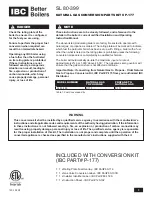
Part number 550-142-085/0712
– 101 –
WM97+
gas
-
fired
water
boiler
—
Boiler Manual
Troubleshooting
(continued)
Check WM97+ control fuses
ALWAYS check WM97+ control fuses before replacing
WM97+ control or any major components (blower, etc.). If
one of these fuses is blown, it can prevent WM97+ control
or other components from operating.
1. Turn OFF power to boiler at external line switch. Then remove the
jacket door.
2. Access the WM97+ control fuses.
a. See Figure 105. Rotate item 1, the inlet air silencer, about 45 degrees
so it will be out of the way.
b. Remove the two screws, item 4.
c. Note the three slots (1, 2 and 3) on either side of the jacket. Lift
the control housing (item 2) until the top support arms are aligned
with slot 2, as shown. Pull the top of the housing forward so the
upper arms swing free. Continue rotating the control housing until
it rests on the jacket lower flange as in Figure 106.
d. Disconnect the ignition wire (at item 7). Remove the control hous-
ing back cover (item 6) by pressing the retainer clips (item 5), then
lifting and pulling cover forward.
3. Remove and inspect the two fuses (items 8 and 9, Figure 107).
4. If necessary, replace one or both of the fuses:
a. Low voltage circuit fuse is 3-amp fast-blow (Littelfuse 326012P).
b. Line voltage circuit fuse is 12-amp slow-blow (Littelfuse 257003).
Do not jumper either fuse or replace with any fuse except as
specified. Failure to comply could result in severe personal
injury, death or substantial property damage.
5. Reinstall control housing cover and return control housing to normal
position. Replace screws (item 4) and reconnect ignition cable at item 7.
Checking temperature sensors
1. The boiler temperature sensors (flue, outdoor, return water and supply
water) are all resistance-type devices. Figure 104 shows the correct value
for the sensor at various temperatures. For dual sensors, the temperature
difference between the sensors must be no more than 10 °F.
2. Use the resistance values at 32°F, 60°F, 70°F and 212°F to measure the
sensor resistance at known temperatures (ice point, room temperature
and sea level boiling point). For ice point and boiling point, insert the
sensor in water at that temperature. Use an ohmmeter to read resis-
tance value.
3. To check whether the WM97+ control is correctly sensing temperature,
you can use a resistance decade box. Connect the decade box temporar-
ily in place of a sensor and read the corresponding temperature on the
WM97+ control display. The temperature should be close to the value
corresponding to the input resistance.
Figure 104
Sensor resistance values
Temp
(°F)
Sensor ohms
Temp
(°F)
Sensor ohms
Temp
(°F)
Sensor ohms
Min
Max
Min
Max
Min
Max
32
34265
37871
90
8504
9399
150
2517
2782
40
27834
30764
100
6847
7568
160
2091
2311
50
21630
23907
110
5545
6129
170
1744
1928
60
16944
18727
120
4517
4992
180
1461
1615
70
13372
14780
130
3698
4088
190
1229
1359
80
10629
11747
140
3043
3364
200
1038
1147
Figure 105
Control housing lifted to slot 2 (jacket
door removed and inlet air silencer
rotated out of the way) (WM97+70
shown)
Figure 106
Control housing rotated forward
(WM97+70 shown)
Figure 107
Control housing with back removed
— close-up of WM97+ control fuse
location on the control board
Содержание WM97+110
Страница 1: ......
















































